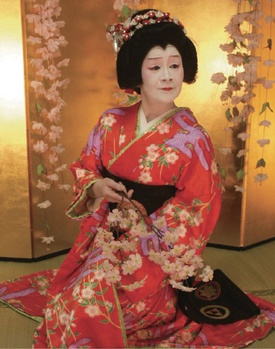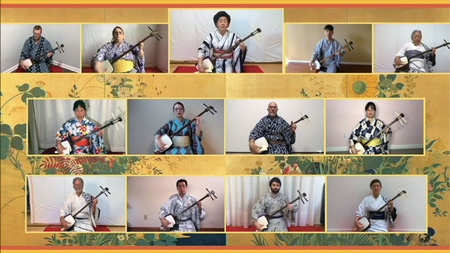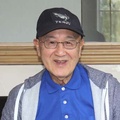The youngest, Mary, loves dancing.
In the Hirakawa household, children called their parents Daddy and Mama, and each of the four children was given an English name. The eldest son, Sumio, was called Victor, and the youngest, Mariko, was called Mary. "So, I've been Mary since I was born. Even now, my students call me Mary-sensei." English was a very familiar language in the Hirakawa household.
The broadcast of Come Come English took an entire day, and Yuichi would take two lunchboxes with him every morning and head to NHK, which was then located on Mt. Atago. He would write and prepare the script for the day in the morning, ready for the 6pm broadcast. After leaving radio broadcasting, he ran an English conversation school and worked in jobs such as vice president of a foreign film import company, but in his later years he would tell his children, "Daddy's life was all about doing Come Come English."
"Unlike me, who was quick to fight, my father was always smiling and calm. I take after my mother," Mary says of her memories of her parents. Her mother, Yone, was a "Kanda native" born and raised in Kanda, Tokyo, and was full of enterprising spirit. "When she was an elementary school teacher, the two of us were selected to go to America to see what schools were like there. After that, she quit her job and went back to America as an exchange student, and that's when she met my father." Her mother, who enjoyed Japanese dance and Kiyomoto (music accompanying Kabuki played on the shamisen), also began training in Japanese dance.
Her older sister, who is three years older than her, stopped dancing in the sixth grade of elementary school, but Mary, who started dancing at age six, continued. During the summer vacation of her third year of high school, she was invited to a US military base to teach children the "Teru Teru Bozu" and "Ehigasa" dances in English, marking the first step in Japan-US exchange by making use of her special skills. At the age of 20, she became a Natori and the name Hanayagi Fumiryu was born. She also began playing Nagauta shamisen at the age of 23 while working at a company, and at the age of 33, she became a Natori Kineie Yachicho.
Mary first visited America when she was 20 years old, to visit her eldest brother, Victor (Sumio). Born in Los Angeles, her brother returned to America on a cargo ship at the age of 15, and after much studying, he graduated from Everett High School, the University of Washington, and New York University Law School. At the time, he was working at a bank in Seattle. During this first visit, Mary attended Seattle University for a year, and during that time, at her brother's urging, she would sometimes perform Japanese dance at schools and other venues.

Eventually based in the United States
In Tokyo, she continued to use her English skills in jobs such as helping out at her father's English conversation school, the Kam Kam Club, with her younger brother and sister, teaching elementary school students, and working for a company. On the other hand, when she visited Seattle, she found meaning in her life by introducing traditional Japanese performing arts on stage, such as Japanese dance and shamisen performances. As she commuted back and forth between Japan and the US, America gradually began to take up more and more of her heart.
In 1983, she finally founded the Kabuki Academy and began taking on apprentices. In the 1990s, she began teaching at Tacoma Community College and Seattle Central Community College (now Seattle Central College). She actively participated in various events and worked to introduce traditional Japanese performing arts. She not only participated in local community Japanese cultural events such as the Seattle Cherry Blossom Festival, but also flew to distant locations upon request, wearing a costume, wig, and sometimes even a shamisen. Some people may have seen Mary at Sea-Tac Airport.
In recognition of his achievements, he was awarded the Gordon Ekbaal Tracy Award, given to performing artists who have contributed to the development and performance of traditional performing arts from other countries in the United States, by the Ethnic Heritage Council of his hometown Seattle in 2002. Numerous other letters of appreciation can be seen on the wall of his rehearsal room.

Even now, amid the COVID-19 pandemic, she teaches Japanese dance, Nagauta shamisen, and Japanese conversation online from Monday to Saturday. For the past 10 years, she has been teaching students online, both across the United States and sometimes outside the United States, so she is no stranger to online classes using Skype, FaceTime, and Zoom.
"Maybe it's because I grew up watching my father pour his heart and soul into teaching English. Teaching requires perseverance, but the joy of teaching is priceless," Mary said. In her holiday card for the end of 2020, she wrote, "Following in my father's footsteps, I intend to continue to work hard to pursue my art and to fulfill my life in my late 70s as a bridge between Japan-US and Japan-Italy cultural exchange."
Forty years have passed since she decided to spread Japanese culture and traditional arts abroad. In an interview, she said, "I want to do this for another 10 years." Her days are as busy as ever, but she enjoys spending time with her two cats.
Set in Seattle, three generations share the history of Japan and the United States

Her grandfather, Sadajiro, came to America from Okayama as a migrant worker in the early 1900s and worked on the railroad. Her father, Yuichi, brought American culture and English skills he acquired through hard work in Seattle back to Japan, becoming a driving force behind the English language boom in Japan during the occupation. His son and Mary's eldest brother, Victor (Sumio), passed away in 2018, but he worked mainly in Seattle as a banker, and served as branch manager of Mitsubishi Bank in the Seattle area during the late 1980s when the Japanese economy was growing rapidly, and also held positions such as president of the Japan-America Society of Washington. Mary is currently active as a private goodwill ambassador promoting Japanese culture and traditional performing arts.
The more I listen to the story, the more I realize that it is a record of three generations of the Hirakawa family that mirrors the changes in Japan-U.S. relations. I was also surprised to see that Seattle is the main setting. This is a drama that is completely different from the TV drama series, but is a genuine Seattle version of "Come Come Everybody."
Mary is currently searching for people who used to listen to Kam Kam English on the radio. "I know people who learned Kam Kam English and found it extremely helpful when they came to America. If you know anyone from back then, please get in touch," she says. To contact Mary, including inquiries about taking classes, please contact kabukiacademy@msn.com or ☎253-564-6081.

* * * * *
Mary Ohno : Born in Tokyo in 1945 as the youngest of four siblings. She began learning Japanese dance at the age of six and Nagauta shamisen in her twenties, earning the titles of Hanayagi Fumiryu in dance and Kineya Yachicho in shamisen. In Japan, she taught English at the Kam Kam Club, which was run by her father, Hirakawa Yuichi (1902-1993), and also worked in the foreign affairs department of Honda Motor Co. In 1983, she founded the Kabuki Academy to introduce Japanese culture and traditional performing arts to America. She also teaches Japanese dance, Nagauta shamisen, and Japanese conversation online.
*This article is reprinted from Seattle lifestyle magazine Soy Source (published on March 13, 2021).
© 2021 Akiko Kusunose / Soy Source






